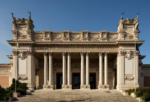About Sculpture #4
.jpg)
Mostra collettiva. Si tratta del quarto e ultimo evento della serie.
Comunicato stampa
Galerie Rolando Anselmi is delighted to present the fourth and last chapter of the on-going project, About Sculpture. The project has evolved throughout the year, with four group exhibitions exploring contemporary sculpture. The artistic relevance of this medium is examined through the work of 25 international artists, born between the 60s and the 80s. The artists included in the exhibitions, ranging from established to emerging, are invited to present one piece, trying to expand and go beyond conventional debates and notions of sculpture. Their works reflect a multi-layered and contradictory image of common media definitions through the implementation of different strategies of investigation and aesthetic parameters. In this occasion we are excited to host works by Nicolas Lamas, Maximilian Schubert, Klaus Weber, A Kassen, Santiago Taccetti, Matt Bryans, Alis/Filliol. The shows aim to build a narrative in space, investigating the relationship between space and material in an effort to exhibit a heterogeneous spectrum of possibilities.
The work of Nicolas Lamas is based on a processing reflection about space, time, culture and science. Lamas formalizes his questioning using various media, playing on codes and undermining constructed perceptions and systems that govern our daily life. His work Partial View, consisting of a rock and a scanner, highlights the meeting of two heterogeneous elements, exposing the relationship between actual weight and the virtual weight of a scanned image and the impossibility of understanding an object if one only considers the surface of things. Through this, he attempts to somehow underline relativity, malleability, and the level of indeterminacy in all of which we attempt to comprehend, searching for an objective and definite truth.
In Maximilian Schubert's wall sculptures, titled Format, lenghts of brass and copper converge at minute hinges, folding the rectangular structure into opposing angles that appear to contract and expand. These works appear paused in space, their motion arrested in one of many possible iterations. Through his works Schubert investigates and questions the concept of representation. The works are reduced to pure form, neither involving direct reference nor attempting to activate particular predetermined associations.
The two large-scale white paintings Untitled (Einstatzbereich Innen - Außen) by Santiago Taccetti, can deceive the viewer, who is forced to walk close to the canvas before realizing that no actual paint is visible. The unpredictable reaction of different material permeates Taccetti's work, which investigates the relationship between sculpture and painting. In this occasion, the artist experimented with different kinds of household paint and used a variety of instruments to press and imprint the material into the reverse of the canvas, creating a beautiful pattern and texture on the surface of the work while the thick layers of paint remain hidden on the reverse.
Alis/filliol presents The Family (La Coperta), part of a series of sculptures started by the artists this year. The artist duo develops its research using disparate materials, mixing natural elements and industrial products, wax, plaster, mechanical grease, wood, plasticine, polystyrene. The continuous experimentation gives birth to figures with grotesque connotations, provoking a deep sense of alienation and uncertainty.
Artist group A Kassen work with performative installation and sculpture. They examine and experiment with the borders between art and non-art, as well as self invented systems that change the functions of things within a given space. In this sense, they form a critique of the institution and draw attention to how we act and navigate in a certain context. For this occasion A Kassen presents a site-specific installation, composed by small fragments of a statue. The pieces are part of a little angel's statue once belonged to the Lauritz de Thurah's Baroque Garden at Gl. Holtegaard in Denmark. The statue was destroyed by the artists, turned into pieces and placed for two years into the ground in front of its original place. After being removed from the garden, they are now neatly displayed on the gallery's floor in a provocative process of re- contextualisation.
Metal items fill the floor of the second exhibition room. This is Matt Bryans' installation, Gravermaskintenner, composed by 18 digging machine teeth sourced by the artist in Norway. The machine teeth are worn out until they have no purpose anymore and are left behind to be recycled as metal or forever discarded, depending on the fluctuating global prices of iron and steel. The pieces are consumed, revealing on the surface every single impact and dent caused by their former use. The artist has carefully collected them, refined, sanded and oiled, making them appear like some mystical objects with a completely different meaning and function.
Klaus Weber’s works call our deepest belief systems into question. With recurring motifs of death, animism and ritualism, his works provide an ironic counterpoint to the shared understanding – social, natural, scientific – that underpins our society. Weber's Witch Ladder is an over-sized version of those used in witchcraft that allows demons to enter a place through the ceiling. Composed of feathers taken from birds bred in captivity and affixed on either side of a rope, it performs a counter-energy by troubling the conditions of reception within the functionalist rationality of the exhibition space. Weber appropriates the magical device undermining the consolidated hierarchical knowledge between producers and receivers and illustrates how our past beliefs still reverberate in the present.



